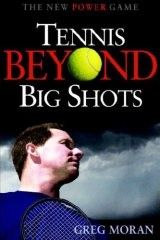July 2004 Article
Mortal Tennis/Circle Game Archive
Tennis Server
|

 |
Growing up, tennis and basketball were my games. If I wasn't on the tennis court (which wasn't often) I was at the gym working on my jumper. If I wasn't practicing my serve I was working on my bounce pass and if I wasn't reading "The Education of a Tennis Player" by "Rocket" Rod Laver I was devouring the biography of Walt "Clyde" Frazier. When I was 13, I severely stretched ligaments in my racket hand. The cast on my right hand made tennis impossible for a few months so I spent that winter at my neighbor's outdoor hoop playing imaginary games against the NBA's best. With my hand wrapped in plaster and snow falling around my ears, I'd dribble past Frazier, soar above Wilt the Stilt and, at the last second, send a bounce pass to the big "O" for an easy lay-up. I won the NBA championship with a last second shot virtually every day of the week that winter. Throughout school I played both sports. In high school, I was a "star" on the tennis team and a "scub" on the J.V. basketball squad. Though I eventually gave up organized basketball for full-time tennis, I've always played pick-up basketball when I could and have been fortunate enough to attend many NBA games as a lifelong Knicks fan. The two sports always went hand in hand for me and playing one taught me things about the other, particularly in regards to strategy. For example, the old Knicks of Frazier, DeBusschere, Reed and Monroe embraced the team concept of patience and making as many passes as needed to get an open shot. From a tennis standpoint, this translated into hitting as many balls as needed to maneuver my opponent out of position so that I would have an easy put away into the open court. As the years went by, both sports seemed to change at the highest level. As the athletes became bigger, stronger and faster, fire replaced finesse and tactics became taboo. The purity of both games was largely lost in the athleticism of their participants. No longer interested in the team concept, basketball games often became run and gun affairs where three point shots and monster dunks replaced the extra pass and the art of boxing out. On the tennis court, 130 m.p.h. serves and super-sonic forehands became the rage. Human nature leads us to emulate our heroes so the approach of the pros trickled down to the masses. Recreational basketball and tennis courts became filled with wannabe clones of the "big boys and girls." Walk by any public basketball court and you'll see players going one on three while their teammates stand and watch. You'll see pull up three pointers while teammates stand wide open under the hoop. On the tennis court, point development has been largely replaced by impatience. Players attempt shots with an attitude that seems to say, "I'm going to hit the ball as hard as I possibly can--------- in case it happens to go in." In my opinion, both games have suffered over the past few years due to this phenomenon. Professional basketball is losing fans to the college game every day and pro tennis has struggled to build a loyal following. Well, help is on the way and it is in the form of a Piston. Watching Detroit upset the dream team Lakers, I saw old school basketball. Strategy, effort and guts defeated showtime. Listening to the remarks by the commentators I was again reminded of how similar basketball and tennis are and how we, as tennis players, can learn from Larry Brown's Pistons blue collar style of play. With that in mind, here's my starting five "team of tips" that we can all take from the NBA finals to the tennis court.
When the Pistons lined up for the opening tip, they looked into the eyes of Shaq, Kobe, Malone and Payton---four of the greatest players to ever lace up a pair of basketball shoes. If the Pistons had listened to the media and the so-called experts, they would have never left the locker room. Fortunately they didn't and neither should you. If you're facing an opponent that is "supposed" to beat you, don't be intimidated. Remember to focus on the ball, not the person you're playing. Play within yourself and remember that the pressure is all on them because they're supposed to win.
This column is copyrighted by Greg Moran, all rights reserved.
Greg Moran is the Head Professional at the Four Seasons Racquet Club in Wilton, Connecticut. He is a former ranked junior and college player and certified by both the USPTA and USPTR. Greg has written on a wide variety of tennis-related subjects for numerous newspapers and tennis publications including Tennis, Tennis Match and Court Time magazines. He is also a member of the FILA and WILSON Advisory Staffs.
Questions and comments about these columns can be directed to Greg by using this form.
|



October 2022 Tennis Anyone: Patterns in Doubles by John Mills. September 2022 Tennis Anyone: Short Court by John Mills. |

 You will join 13,000 other subscribers in receiving news of updates to the Tennis Server along with monthly tennis tips from tennis pro Tom Veneziano.
You will join 13,000 other subscribers in receiving news of updates to the Tennis Server along with monthly tennis tips from tennis pro Tom Veneziano. 